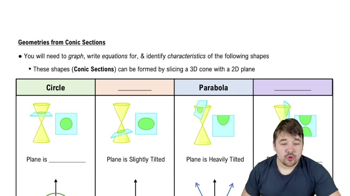Table of contents
- 0. Fundamental Concepts of Algebra3h 29m
- 1. Equations and Inequalities3h 27m
- 2. Graphs1h 43m
- 3. Functions & Graphs2h 17m
- 4. Polynomial Functions1h 54m
- 5. Rational Functions1h 23m
- 6. Exponential and Logarithmic Functions2h 28m
- 7. Measuring Angles40m
- 8. Trigonometric Functions on Right Triangles2h 5m
- 9. Unit Circle1h 19m
- 10. Graphing Trigonometric Functions1h 19m
- 11. Inverse Trigonometric Functions and Basic Trig Equations1h 41m
- 12. Trigonometric Identities 2h 34m
- 13. Non-Right Triangles1h 38m
- 14. Vectors2h 25m
- 15. Polar Equations2h 5m
- 16. Parametric Equations1h 6m
- 17. Graphing Complex Numbers1h 7m
- 18. Systems of Equations and Matrices3h 6m
- 19. Conic Sections2h 36m
- 20. Sequences, Series & Induction1h 15m
- 21. Combinatorics and Probability1h 45m
- 22. Limits & Continuity1h 49m
- 23. Intro to Derivatives & Area Under the Curve2h 9m
19. Conic Sections
Introduction to Conic Sections
Struggling with Precalculus?
Join thousands of students who trust us to help them ace their exams!Watch the first videoMultiple Choice
How can you slice a vertically oriented 3D cone to get a 2D parabola?
A
Slice the cone with a horizontal plane.
B
Slice the cone with a slightly tilted plane.
C
Slice the cone with a heavily tilted plane.
D
Slice the cone with a vertical plane.
 Verified step by step guidance
Verified step by step guidance1
Understand the geometry of a cone: A cone is a three-dimensional shape with a circular base and a single vertex. When slicing a cone, the orientation of the plane relative to the cone determines the shape of the cross-section.
Consider the orientation of the plane: To obtain a parabola, the plane must be tilted relative to the axis of the cone. A horizontal plane will produce a circle, while a vertical plane will produce a hyperbola.
Visualize the slicing process: Imagine a plane that is tilted at an angle, not parallel to the base and not perpendicular to the axis of the cone. This plane should intersect the cone in such a way that it cuts through both the curved surface and the base.
Determine the angle of tilt: The plane should be heavily tilted, meaning it is angled enough to intersect the cone in a way that the cross-section forms a parabola. This requires the plane to be neither too shallow nor too steep.
Recognize the resulting shape: When the plane is heavily tilted, the intersection with the cone will form a parabola. This is because the curve of the cone and the angle of the plane create a parabolic shape in the cross-section.

 3:8m
3:8mWatch next
Master Geometries from Conic Sections with a bite sized video explanation from Patrick
Start learningRelated Videos
Related Practice


